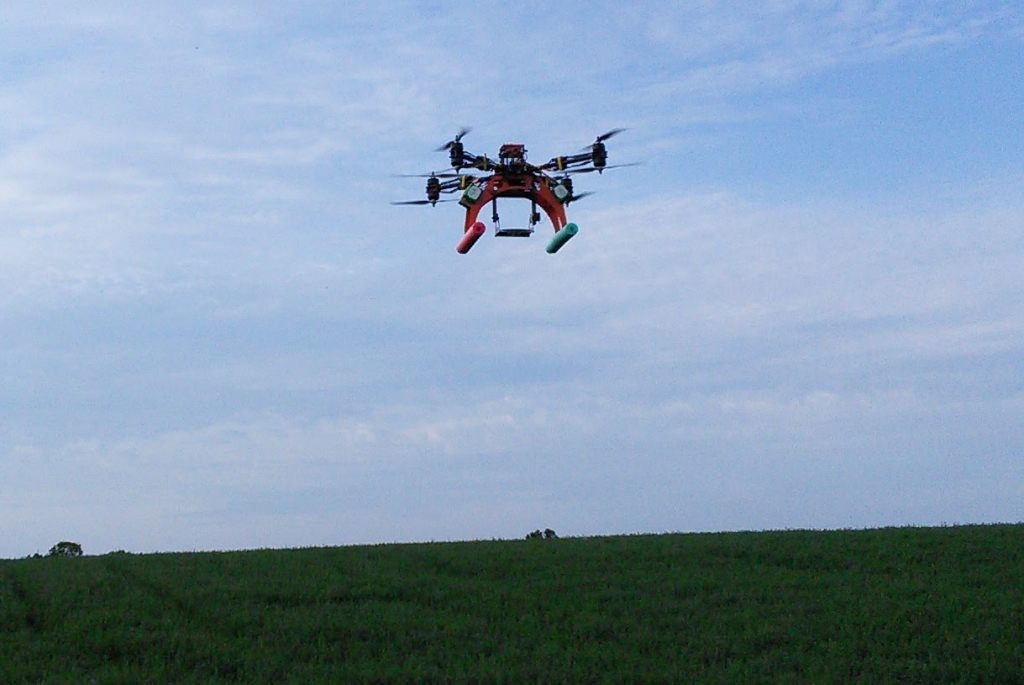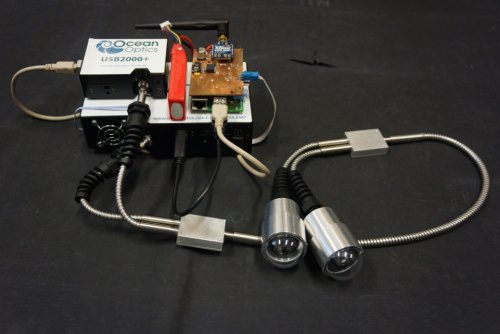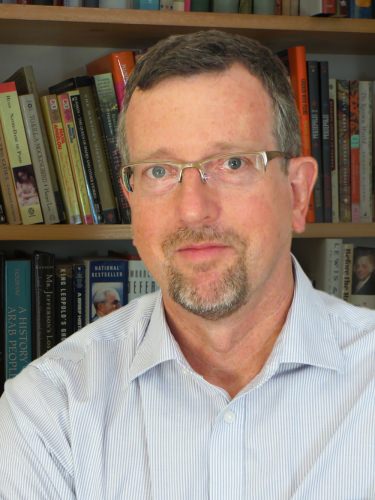UW–Madison adopts drone use policy

This X8 multi-rotor copter is used by researchers in the Townsend lab in the UW–Madison Department of Forest and Wildlife Ecology for spectroscopy and remote sensing to study the functioning of ecosystems. The UAV is 5½ feet in diameter and weighs almost 40 pounds with all sensors and imagers attached. Photo: Clayton Kingdon
A new UW–Madison policy will help researchers and instructors on campus meet the Federal Aviation Administration rules for flying unmanned aircraft systems (UAS) — better known as aerial drones — while also helping to protect privacy.
The policy, “University of Wisconsin–Madison Unmanned Aircraft Systems (UAS) Policy,” encourages safe and lawful use of drones for research and instruction. The policy provides a drone use approval process and replaces a previous campus policy that prohibited students, staff or outside entities from operating unmanned aircraft/drones on the UW–Madison campus, interiors or exteriors. The new policy allows for some drone use for research and teaching, and is a joint effort of the vice chancellor for research and graduate education and the vice chancellor for finance and administration.
This policy applies to drone operations in both indoor and exterior spaces and in connection with UW–Madison activities, whether occurring within the United States or internationally. The policy does not apply to drone operations by the University of Wisconsin Police Department or other first responder operations conducted in accordance with applicable law.
For safety and privacy reasons, drone operations by students, employees or visitors for recreational or hobbyist purposes are still not permitted on UW–Madison premises. Drone operations by registered student organizations and by students in connection with UW–Madison coursework are eligible to be considered for approval under this policy as instructional uses.

Steve Ackerman says UW–Madison is a challenging environment for drone use of any kind or for any purpose. Photo: Jeff Miller
UAS operations by third parties for marketing and promotional purposes also are not permitted under this policy and should be directed to Tricia Nolan at University Marketing.
Steve Ackerman, associate vice chancellor for research in the physical sciences, explains that UW–Madison is a challenging environment for drone use of any kind or for any purpose given its location in an urban environment, located just miles from the Dane County Regional Airport and Middleton Municipal Airport, and in close proximity to UW Health’s Med Flight base. He adds that the policy will be revisited as drone technology changes in a dynamic regulatory environment.
Grant Petty, UW–Madison professor of atmospheric science, echoes Ackerman’s sentiments and notes that at the technological level, the capabilities and potential uses of unmanned aerial vehicles (UAVs) are advancing at breakneck speed.
“This rapid development has posed a major challenge to both the FAA, which is racing to come out with appropriate regulations governing the use of UAVs, and to prospective faculty, staff and student users of UAVs, who must understand and operate within those rules as they are created,” says Petty.
Prior to August 2016, the FAA’s position was that every nonrecreational use of UAVs required an application for an exemption from existing rules. This requirement posed a serious barrier to entry that has now been greatly lowered. UW–Madison’s policy reflects the FAA’s new rules. The FAA also no longer requires handlers to have a pilot license to fly a drone.
The UW–Madison policy also calls for establishing a UAS Ethics and Safety Committee, with broad campus representation, to make timely reviews of drone use applications.
Under the new policy, the approval process requires that UW–Madison faculty, staff, students, contractors and affiliates seeking to operate UAS for UW–Madison-related education, research and nonacademic (such as facilities uses) purposes to answer questions provided in the policy appendix and submit those to the UAS Ethics and Safety Committee for review no less than 30 days in advance of the first proposed flight date. The application should be emailed to drones@research.wisc.edu.
If an applicant’s planned operation will require a waiver of FAA rules, it is recommended that the applicant apply for the waiver at least 90 days in advance of the first proposed flight date. Applications for waivers are submitted through the FAA website.

The Piccolo dual-view spectrometer is fitted to a heavy-lift UAV. UW–Madison Townsend lab manager Clayton Kingdon hopes that this platform will help “fill the gaps” between leaf- and pixel-level spectroscopic measurements. Photo: Alasdair MacArthur
The committee will recommend the application for approval provided it adequately describes the proposed activity and reasonably assures that the proposed activity meets the requirements of the policy and related procedures, as well as the applicable laws and regulations. Applications for operations requiring an FAA waiver will be conditionally approved if the waiver is still pending, with final approval granted upon receipt of the FAA waiver.
“I think the administration has done a good job of involving stakeholders in reviewing and providing input into the draft policy,” says Petty. “The policy encourages research and educational applications of UAVs while maintaining a sensible level of oversight. We are certainly in a far better position today to explore innovative applications of UAVs than we were a year ago.”
Petty’s own interest in UAVs lies in the possibility of obtaining flexible and inexpensive measurements of the lower atmosphere, partly in support of an undergraduate course that he co-teaches on meteorological measurements.
“I love the idea of getting students excited about not only the use of UAVs to observe the Earth’s atmosphere and surface, but also the associated advances in low-cost sensor and microprocessor technologies,” he says.
Phil Townsend, a UW–Madison professor of forest and wildlife ecology, uses drones outfitted with spectrometers to measure agricultural fields and natural ecosystems. The data that is collected is used to measure chemistry and physiology of vegetation.
“Drones offer opportunities that we just don’t have with airplanes or satellites,” Townsend says. “We control when we collect data — we can get high-resolution images and measurements on the days and at the times we want. Think of it as ‘just-in-time’ science. We also can collect high resolution data at low elevations that you don’t get from satellites or most airplanes.”
Townsend says it is critically important to have a campus drone policy because funding agencies require it, and to ensure safety.
“We have been told by NASA to not even consider trying to publish our results unless we are entirely compliant with both FAA and NASA regulations for drone use,” Townsend says. “It also provides us with the reasonable bounds for what we can do in our science. It cannot be emphasized enough that a runaway UAV can be very dangerous. Being able to assure all of this in proposals and reports provides more confidence to our funders, constituents and stakeholders.”
Clayton Kingdon, a researcher in the Townsend lab and FAA-licensed UAV pilot, is encouraged to have the new policy in place.
“The inability to fly on campus has been particularly frustrating,” Kingdon says. “For my research, the need for a policy to allow regulated on-campus UAV operations is driven by practical considerations. My lab is developing remote sensing technology that is tightly integrated with a large multi-rotor UAV, not simply attached to it. Our UAV is 5½ feet in diameter, and weighs almost 40 pounds with all sensors and imagers attached.”
Kingdon currently does test flights at UW’s Arlington Agricultural Research Station, which is a 30-minute drive from central campus.
“To test even the most minor modifications, my crew and I must load our UAV, batteries, tools, and safety equipment into a truck and drive to Arlington,” he says. “If we can fly on campus then not only would the logistics for test flights be simpler but (and probably more importantly) we would make much faster progress towards achieving our science objectives.”
A separate application form and approval process managed by the UW–Madison Division of Facilities Planning and Management applies to requests for UAS operations by facilities planning and design consultant teams, or on behalf of architects, engineers or construction contractors engaged in facility projects on UW lands pursuant to contracts issued by the State of Wisconsin Department of Administration or by the University of Wisconsin System Administration on behalf of UW–Madison. Contact Gary Brown for more information on facilities drone use.
See the FAA website for more information on drone regulations in the United States.






